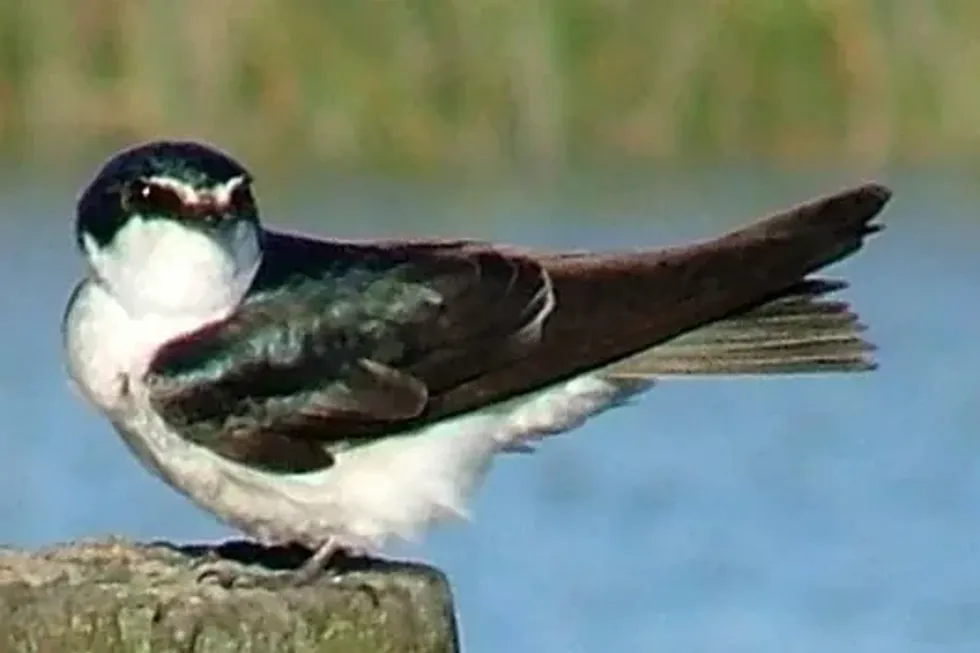Swallows are birds of the world thanks to their love for migrating amongst a vast range of places. Swallows are also easily found near human habitats and are known for their chirping sounds. There are around 80 species of swallows, but right now we will be taking a deeper dive into the white-rumped swallow!
The white-rumped swallow has the scientific name Tachycineta leucorrhoa. It is a species of bird in the class Aves and the family Hirundinidae.
In his 'Nouveau Dictionnaire d'Histoire Naturelle', French researcher Louis Vieillot first described this bird species. The white-rumped swallow was first formally described as Hirundo leucorrhoa in Vieillot's 'Nouveau Dictionnaire d'Histoire Naturelle', but it is now known as Tachycineta leucorrhoa. This bird is classified as Least Concern by the IUCN.
The white-rumped swallow (Tachycineta leucorrhoa) is often confused with the Chilean swallow. To find out more facts about the accurate identification of white-rumped swallows, as well as their order, family, genus, species, and more, keep on reading. To learn about more birds of the world, read about the swallow-tailed kite and the cliff swallow here on Kidadl.
White-Rumped Swallow Interesting Facts
What type of animal is a white-rumped swallow?
A white-rumped swallow is a bird from the family Hirundinidae.
What class of animal does a white-rumped swallow belong to?
A white-rumped swallow belongs to the Aves class and the family Hirundinidae.
How many white-rumped swallows are there in the world?
The exact population of the white-rumped swallow (Tachycineta leucorrhoa) is unclear but we do know that this bird species' distribution is across southern South America.
Where does a white-rumped swallow live?
White-rumped swallow (Tachycineta leucorrhoa) birds are found in tropical rainforests in South America. They are found in a range of countries including, Bolivia, Peru, Brazil, Paraguay, Uruguay, and Argentina. In Spanish, a swallow is known as a 'golondrina'.
What is a white-rumped swallow's habitat?
White-rumped swallow (Tachycineta leucorrhoa) birds are found near tropical wet places. A white-rumped swallow bird will typically find its tropical habitat near ponds, streams, and rivers.
Who does a white-rumped swallow live with?
The white-rumped swallow (Tachycineta leucorrhoa) is a species of swallow birds that live near other swallows. After their breeding season is finished, white rump swallows create flocks with a population that can range in the hundreds. This flock population can consist of the white-rumped swallow and other species of swallows too!
How long does a white-rumped swallow live?
Sadly, many swallows die within three years due to starvation. If a white-rumped swallow can survive beyond this point, its can life-expectancy range from three to 16 years. The bird is classified as Least Concern by the IUCN, so we do not need to worry too much about this relatively short lifespan.
How do they reproduce?
Adult white-rumped swallow (Tachycineta leucorrhoa) birds attract a mate for breeding through songs. A male white-rumped swallow sings a song when seeking a partner, and it is up to the female swallow to determine the male's physical condition.
Their courtship is solely based on their natural singing ability, it is pretty much a music competition!
The breeding period for white-rumped swallow (Tachycineta leucorrhoa) birds last from October to February in Argentina and from October to December in Brazil. In other countries where a distribution of these birds is found (such as Bolivia, Paraguay, Uruguay, and Peru), this breeding season can vary further.
What is their conservation status?
According to the International Union for Conservation of Nature (IUCN), the white-rumped swallow's conservation status is Least Concern. These birds from the Hirundinidae family are found in a range of countries, from Peru and Brazil to Argentina and Paraguay.
White-Rumped Swallow Fun Facts
What do white-rumped swallows look like?
A white-rumped swallow (Tachycineta leucorrhoa) has a natural white streak above its eyes and nostrils, this is how you can tell a white-rumped swallow from a Chilean swallow! The white-rumped swallow (Tachycineta leucorrhoa) has a black tail, black ears, and black wings.
The white-rumped swallow (Tachycineta leucorrhoa) also has a white rump, white underparts, and white underwing coverts. The upper outer parts of a white-rumped swallow (Tachycineta leucorrhoa) have a glossy blue coating of feathers.

*Please note that this is an image of a barn swallow, not a white-rumped swallow. If you have an image of a white-rumped swallow, please let us know at hello@kidadl.com.
How cute are they?
White-rumped swallow (Tachycineta leucorrhoa) birds are considered to be quite cute thanks to their small size, blue feathers, white ‘orrhos’ (rump), and natural singing notes.
How do they communicate?
The White-rumped swallow (Tachycineta leucorrhoa) and most species of swallows, communicate by creating different natural calls or sounds. The usual sound a white-rumped swallow (Tachycineta leucorrhoa) makes is a musical and soft chirp.
The white-rumped swallow (Tachycineta leucorrhoa) has different songs which are used to communicate to others within their species, to warn others of possible dangers, to express their happiness, and for courting.
How big is a white-rumped swallow?
The white-rumped swallow (Tachycineta leucorrhoa) is 5.1 in (13 cm) long and has a wingspan of 4.56 in (11.57 cm). The average wingspan of a white-rumped swallow (Tachycineta leucorrhoa) is nearly 10 times smaller than the hawk's average wingspan.
How fast can a white-rumped swallow fly?
A white-rumped swallow (Tachycineta leucorrhoa) bird's wings beat four to eight times per second. This is considered slow and stiff, so they aren't particularly speedy fliers.
How much does a white-rumped swallow weigh?
An adult white-rumped swallow (Tachycineta leucorrhoa) weighs 0.60–0.74 oz (17–21 g).
What are the male and female names of the species?
Based on our studies, there are no specific names for a male and female white-rumped swallow, Tachycineta leucorrhoa.
What would you call a baby white-rumped swallow?
Baby white-rumped swallow (Tachycineta leucorrhoa) birds are called nestlings or chicks.
What do they eat?
A typical white-rumped swallow diet consists of flies, beetles, flying ants, and various small insects. A white-rumped swallow (Tachycineta leucorrhoa) typically hunts for the food in its diet near water, in open woodland areas, and pastures.
Are they dangerous?
Not really, but there are a few cases when a white-rumped swallow is considered dangerous. The first incense is if people get too close to their territory or nest.
In this case, an adult white-rumped swallow will attack because they feel threatened. White-rumped swallows, and all other swallows, also carry bacteria and parasites in their droppings that can be linked to serious diseases.
Would they make a good pet?
No, a white-rumped swallow would not make a good pet. Although they are quite cute, white-rumped swallow (Tachycineta leucorrhoa) birds are considered wild animals. These wild birds need a range of space to fly and search for food. In many places, it is illegal to own a white-rumped swallow or any species of swallow.
Did you know...
The white-rumped swallow is a migratory bird. There is a small population of white-rumped swallows in Spain and Morocco
A female white-rumped swallow typically lays one egg, but sometimes two eggs are laid at a time. Nearly 58% of nests produce at least one egg each season.
It takes 10-21 days for this swallow's eggs to hatch, but 14-18 days is the average hatching period. Swallow chicks hatch naked with their eyes closed, and it takes 10 days for their eyes to open.
A white-rumped swallow (Tachycineta leucorrhoa) requires up to 1,200 trips to successfully build a nest. Only female white-rumped swallow birds line their nest for their eggs. A white-rumped swallow will also happily move into an artificial nest that looks like its own nest.
There are nearly 84 species of swallows in total! Swallows are found in every convenient, except Antarctica.
Swallows have short legs, which are accustomed to perching rather than walking, and the longer a white-rumped swallow's tail is, the easier it is for them to move and fly. Longer tails on male white-rumped swallows are also considered more attractive to females.
Although they look alike, swallows and swifts are not related.
These birds do not need water breaks! All species of swallows always drink whilst flying, they simply fly low near water and take a sip while still flying.
The white-rumped swallow (Tachycineta leucorrhoa) is bigger than the Chilean swallow
The white-rumped swallow (Tachycineta leucorrhoa) can travel on average 200 miles (322 km) a day. It usually takes a white-rumped swallow up to 40 days to reach their destination when migrating and they rarely stop while in pursuit.
According to folklore, if you see the first swallow of the year it is considered a good omen.
In Spanish, 'golondrina' is the word for 'swallow'. So, in Spanish, 'golondrina rabadilla blanca' is another name for this bird.
How to tell male and female white-rumped swallow birds apart?
Adult male and female white-rumped swallow (Tachycineta leucorrhoa) birds are nearly identical in appearance, so it is quite difficult to distinguish between them. According to some experts, a male white-rumped swallow bird has a slightly large tail than a female bird.
Are white-rumped swallows endemic?
Yes, the white-rumped swallow (Tachycineta leucorrhoa) is a species that is considered endemic. White-rumped swallow birds are found in South America, in countries including Bolivia, Argentina, Brazil, Peru, Paraguay, and Uruguay.
Here at Kidadl, we have carefully created lots of interesting family-friendly animal facts for everyone to discover! Learn more about some other birds including the goliath heron or the king quail.
You can even occupy yourself at home by coloring in one of our free printable white-rumped swallow coloring pages.










